We were not supposed to be in England. Three weeks prior, my dad had forwarded me an email from my uncle. My Nana’s condition was terminal—a word we’d come close to using every few months for several years, as her dementia worsened. This time seemed to be the real thing.
Plans were promptly made. A series of phone calls. A letter from her doctor. A hurried, apologetic email to my boss.
Two nights before I left, I got a text from my dad telling me Nana had died; a brief, sensitively worded missive, giving me the information I needed and little more. So much of this took place through writing, and so much of this writing was necessarily concise. Blunt, but not without feeling. It’s a matter of expediency. Talking is awkward and expensive.
I insisted upon travelling five days after my parents left. I told them I couldn’t afford to take three weeks off work. In hindsight, that seems silly.
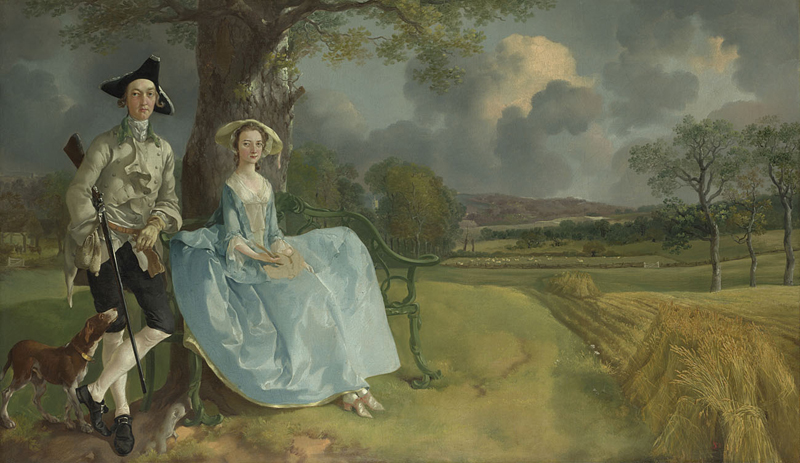
Thomas Gainsborough, Mr and Mrs Andrews, c. 1750, oil on canvas. Image courtesy of The National Gallery, London.
On the plane, between Black Panther, Justice League and a season of Veep, and omelettes and fruit plates, I finished reading John Berger’s Landscapes (2016). The book spans Berger’s career over more than five decades, revealing his steadfast commitment both to a revolutionary socialism, and his unwavering belief in the transformative potential of art—even as he remains suspicious of it. Berger argues again and again for a close, slow, almost painful kind of attention. He’s fierce and compassionate and, throughout, maintains a desire to be moved, broken and rebuilt by art.
A painting by Thomas Gainsborough, Mr and Mrs Andrews (c. 1750), wraps around the front and back covers. The front shows rolling fields, ploughed rows in the foreground, leading us back towards grazing sheep fenced in safely, hills leading towards a grey sky, clouds, perhaps about to part. On the back, Robert Andrews and his wife, Frances Mary Carter, dressed up in frills, pose in front of a tree. Their faces almost lack expression. They seem satisfied.
Berger doesn’t have much to say about Gainsborough in Landscapes. The book is in two parts. The first traverses the thinkers who shaped Berger’s own practice—among them Bertolt Brecht; Walter Benjamin; Karl Marx, of course; Rosa Luxemburg; James Joyce; Gabriel García Márquez; Berger’s adolescent mentor Ken. The second part surveys the uses to which he puts these thinkers. Cumulatively, the book articulates Berger’s theory of art. There are no timeless works of art for Berger. All art exists in time, in history. There may be great works, and embedded in these works is the machinery of social and economic relations that structured the works’ creation. But there’s more to these works, too, something that makes them persist. Artworks can, Berger writes, “increase our awareness of different potentialities of different people.” He goes on:
The important point is that a valid work of art promises in some way or another the possibility of an increase, an improvement . . . it is essential to remember that the specific meaning of a work of art changes—if it didn’t, no work could outlive its period, and no agonist could appreciate a Bellini. The meaning of improvement, of the increase promised by a work of art, depends on who is looking at it when. Or, to put it dialectically, it depends on what obstacles are impeding human progress at any given time.2
In Ways of Seeing (1972), the first book I ever read by Berger, the author offers a swift, elegant critique of Kenneth Clark’s reading of Mr and Mrs Andrews. For Clark, the painting demonstrates Gainsborough’s skill as a landscape painter, he calls it an “enchanting work” painted with “love and mastery.”3 Berger disagrees: he writes that Mr and Mrs Andrews “are not a couple in nature as Rousseau imagined nature. They are landowners and their proprietary attitude towards what surrounds them is visible in their stance and their expressions.”4 It’s such a deft, concise and typically Marxist reading. It doesn’t, of course, suggest what a contemporary viewer may do with a Gainsborough (more on that later), but it enfolds into the work an entire realm of property relations. It makes the painting a performance; the sitters, in their ribbons and silks are performing for us, yes, but the painting does something, it acts. The painting realises the sitters’ claims to sovereignty over the landscape depicted. Berger stares through the aloof gaze of Mr and Mrs Andrews and reveals two members of an anxious, newly powerful merchant class, thereby situating the painting on the precipice of the capitalism we know today.
As is to be expected from any Marxist, property preoccupies Berger’s writing. A tension runs through Berger’s work. He remains keenly aware of the historical entanglement between art and religious, economic and political power; with the ways art and its associated virtues of enlightenment, culture and good breeding have been used to oppress. He’s at his most ferocious when he writes of art’s current occupation as a plaything of the rich. The opening lines of an essay titled “Art and Property Now,” originally published in 1969, read:
A love of art has been a useful concept to the European ruling classes for over a century and a half. The love was said to be their own. With it they could claim kinship with the civilisations of the past and the possession of those moral virtues associated with “beauty.” With it they could also dismiss as inartistic and primitive the cultures they were in the process of destroying at home and throughout the world.5
He goes on to condemn the artwork of the 1960s for its willingness to embrace the shiny world of commodities. He’s sympathetic towards the avant-garde’s increasingly outrageous attempts to evade the recuperation of art into the market, but, ultimately, he concedes that such efforts were (are still) unsuccessful. Capital is too creative, too cunning. It feels remarkably contemporary. The essay doesn’t offer any way out, and yet, in spite of this, Berger remains committed to art.
There’s a tenderness to Berger, too. This is especially clear towards the end of the book, as he tries to navigate the historical upheavals of the last thirty years. In one of Landscapes’ final essays, he writes of a carved dove—a folk-tradition from Eastern Europe, a votive of hope made to keep the winter kind. These doves, pieced together by countless anonymous hands over centuries, made for private reasons, are afforded the same consideration by Berger as art history’s masterpieces. He writes,
One is looking at a piece of wood that has become a bird. One is looking at a bird that is somehow more than a bird. One is looking at something that has been worked with a mysterious skill and a kind of love.6
Time after time, when looking at a work of art, Berger returns to the body of its maker; to hands manipulating matter for purposes of posterity, or ritual, or something not named so easily. And, time after time, Berger lets himself be surprised by what bodies are capable of.
This isn't about John Berger, and it is. This was supposed to be a reflection on writing about art. Extended Conversations permits a kind of indulgence I wouldn’t usually allow myself. In a crisis like the death of a family member, art writing feels indulgent, writing about art writing even more so. I posed a question, a problem weighing on my mind that’s taken me a while to articulate. What keeps us committed to art and what keeps us writing about it? Or, what keeps us embedded in an economy so flagrantly unfair, an arena of almost entirely unregulated financial speculation, whose stewards are underpaid, if paid at all, overworked and forced to exert a considerable amount of energy defending the entire enterprise? There are no answers here, so far as I can tell. Life (death) got in the way of arriving anywhere.
Death slows time. It demands a different kind of attention. There was a lot of organising that needed doing, but none of it seemed to involve me. I wasn’t involved in planning the funeral—beyond proofreading my dad’s eulogy—or settling the estate. I cooked, but it wasn’t taxing. Mostly, there was a lot of doing not much: being in a city, a town, really— Hereford—which I hadn’t been to in over a decade, seeing people I hadn’t seen for as long. We stayed in an Airbnb opposite a cathedral. I can’t remember ever having gone inside (though I must have). Mostly we talked about Nana: her childhood in Wales, her garden, the strange, unreproducible musty smell of her home in Ellesmere, her birds, her frogs. We didn’t talk about art. My family don’t much care for it. There was art in Nana’s home, I’m sure. She could never afford anything by anyone whose name I would know. I remember seascapes, pictures of boats, of no place in particular, or at least no place I knew. My family—my mum, my dad, my two older sisters and I—hadn’t spent this much time together since my oldest sister left for university. We got on each other’s nerves. Our proximity to one another seemed to make us more ourselves. My dad spent an afternoon worried that mildew on my grandmother’s prints of Chester (my hometown) would get them confiscated by New Zealand Customs. Berger was with me, sort of. Mostly he was in my bag. There were a lot of half-thoughts, lines of enquiry I might otherwise follow, but couldn’t bring myself to.
Art, in this instance, didn’t help me mourn. I didn’t ask it to. There were no great epiphanies. There was no weeping in front of paintings. As a narrative device, my grandmother’s death here serves only as an excuse for my distracted, almost half-hearted looking. Maybe she’s here to remind me how unimportant art seems during times of crisis. Which isn’t to say that art can’t be used as a tonic, but entering any relationship with art with the expectation that it will do something in particular, serve a particular purpose, seems fruitless. Art is useless, but maybe productively so.
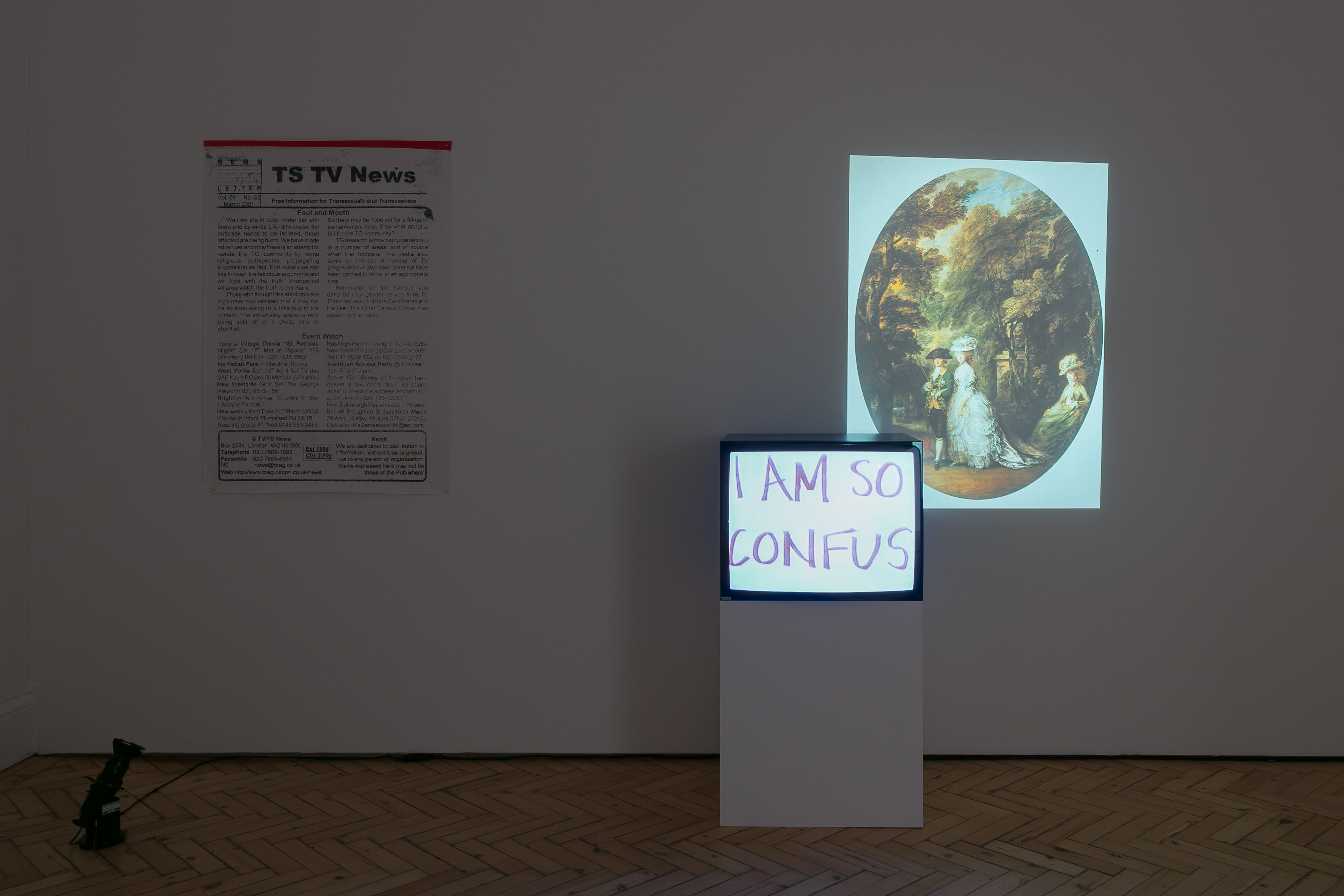
Ian White, Any frame is a thrown voice, 2018, installation view at Camden Arts Centre. Image courtesy of Mark Blower and Camden Arts Centre.
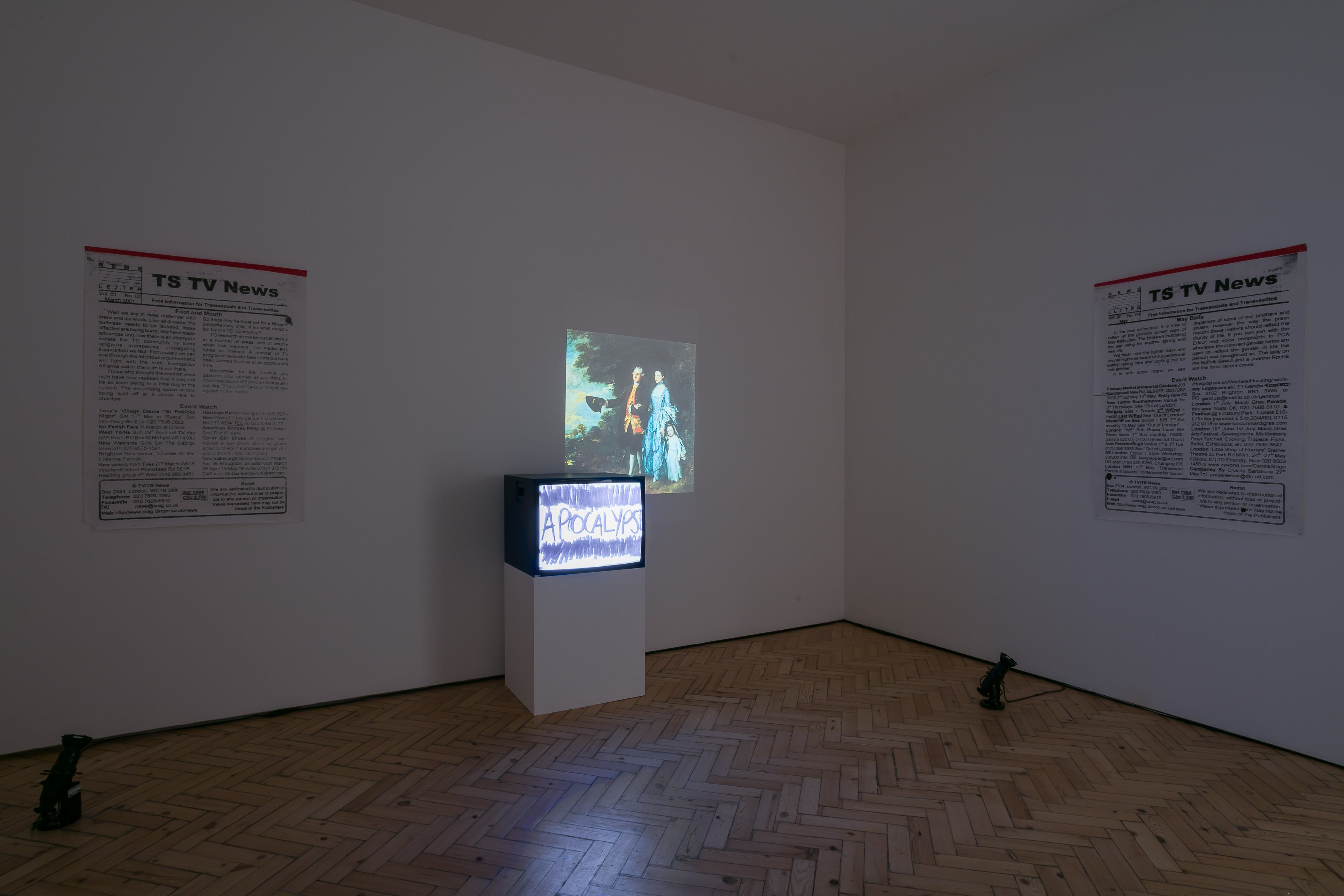
Ian White, Any frame is a thrown voice, 2018, installation view at Camden Arts Centre. Image courtesy of Mark Blower and Camden Arts Centre.
I spent my final two days in London. It seemed important to see things. I wasn’t looking for Thomas Gainsborough, but I found him, once more, at Camden Arts Centre, in Ian White’s posthumous exhibition Any frame is a thrown voice (2018), curated by Kirsty Bell and Mike Sperlinger.7 In a small space lit by light spilling from other rooms, slides of Gainsborough paintings are projected onto a wall—all frilly and ruffled, and, since they had a job to do, completely formulaic. Below and to the left, a video of shakily presented handwritten captions. Above, on two adjacent walls in the gallery, pages from Transsexual-Transvestite News, a newsletter distributed among the trans community in the UK in the early 2000s, were displayed. A soundtrack accompanied the work, some strange, half-identifiable litany, which sounded somewhere between English and French. Much of my attention was directed towards discerning some meaning from the sounds I heard, but to little avail. I learnt later it was a reading of Chaucer’s The Knight’s Tale in Middle English. White described the work as “Gainsborough’s paintings (slide show) read as psychotic by a gay hysteric.”8 Kirsty Bell describes it as “an act of counter-reading.”9
It’s queer, and baffling, and kind of silly. It’s pedagogical in its staging—the slide projector, the dimmed lighting, the bench on which visitors are invited to sit during the forty-minute-long work—but it doesn’t seem to teach us much about Gainsborough’s work, per se. Or rather, it eschews almost all received wisdom about Gainsborough—why he might be an Important Painter, why he’s worth looking at. Instead, the work plunges into wild speculation based on trivia about Gainsborough’s biography. We’re following the artist/performer along some loose train of thought. We’re often led to dead ends, or things that seem so outlandish they barely register as information. The caption accompanying Gainsborough’s portrait of Mary Countess Howe (c. 1764) reads simply, “Sunhat?”. The paper is held shakily towards the camera, it moves closer, the word weirdly negates itself, becoming “unhat?,” before being peeled, revealing, beneath it, a caption that reads “G. ‘had a penchant for the ladies.’” Accompanying Gainsborough’s portrait of The Byam Family (c. 1762–66), in thick black capital letters, bordered by an angry scribble, the word “APOCALYPSE.” In an interview with Giles Bailey, White says the work points towards, “relationships with his sisters who ran haberdashery shops . . . proposing there was some odd, potentially incestuous thing with his sisters and his father.”10 I don’t know enough about Gainsborough to comment on his relationship with his family. The work is an intervention in the production of meaning, proposing that the context of an encounter shapes what information is made legible in that encounter, but it also expands what seems possible to interpret as information. Wild, fanciful speculation, odd, otherwise completely impossible associations made evident only through the proximity of things in time and space are here equivalent to historical fact, or historical rumour, or the overbearing presence of the Western canon. It’s all noise, and it all seems important.
Any frame is a thrown voice is structured around its own limitations. White’s art practice was mostly performance-based. He was also a writer, curator, teacher, among other things. Restaged as an installation, The Neon Gainsborough seems to be one of the most successful works in the show, most likely because White’s body was never strictly necessary for the work. Where other works rely on moving and static documentation for their realisation, the elements of The Neon Gainsborough—the slideshow, videoed captions, soundtrack—can be pieced together in an approximation of its original staging.11 Other works include videos or photographs of White and his collaborators moving through space in front of and around an audience, thereby pointing to an absence, making us painfully aware that we’ve arrived too late to see the work as it was originally imagined. None of this is intended as a criticism of Bell and Sperlinger’s efforts, for the absence of White’s body is structured into the show itself. The show succeeded in putting White’s work in context, and in expanding upon the propositions he made during his lifetime; collaborators, students and other performers associated with White were invited to respond to his work during the course of the exhibition.
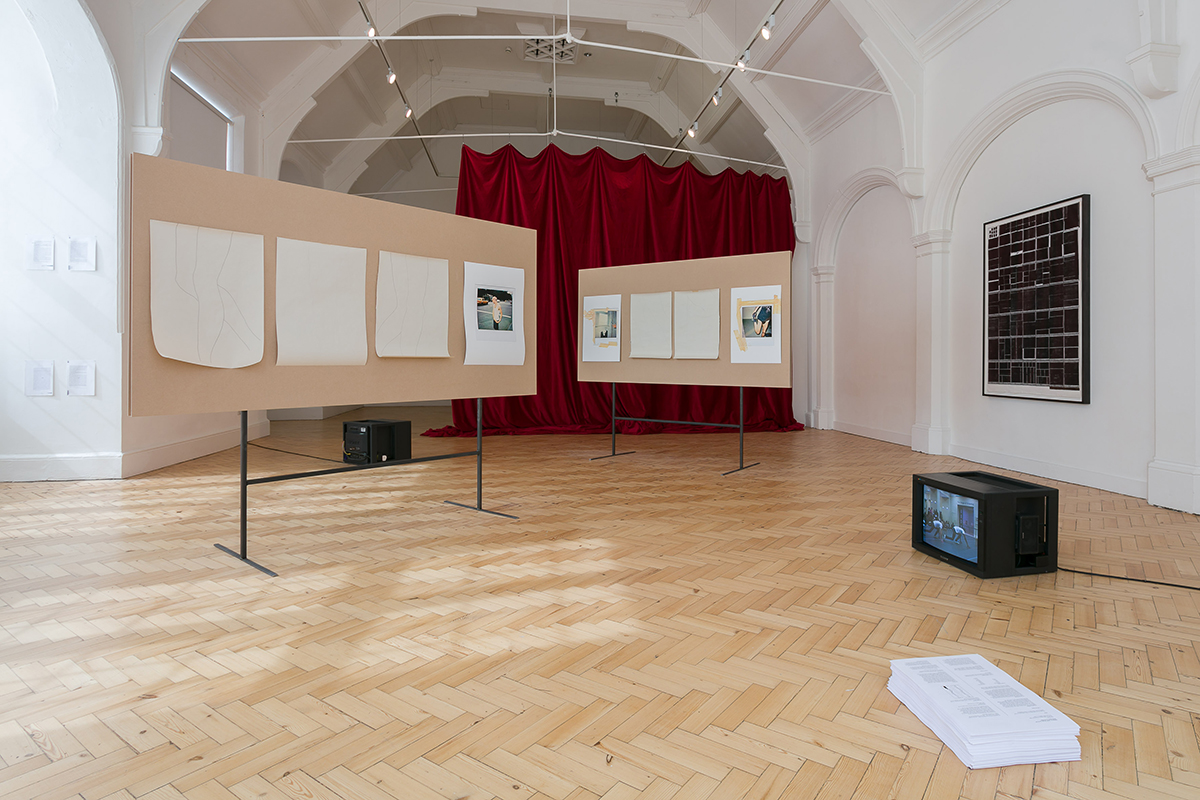
Ian White, Any frame is a thrown voice, 2018, installation view at Camden Arts Centre. Image courtesy of Mark Blower and Camden Arts Centre.
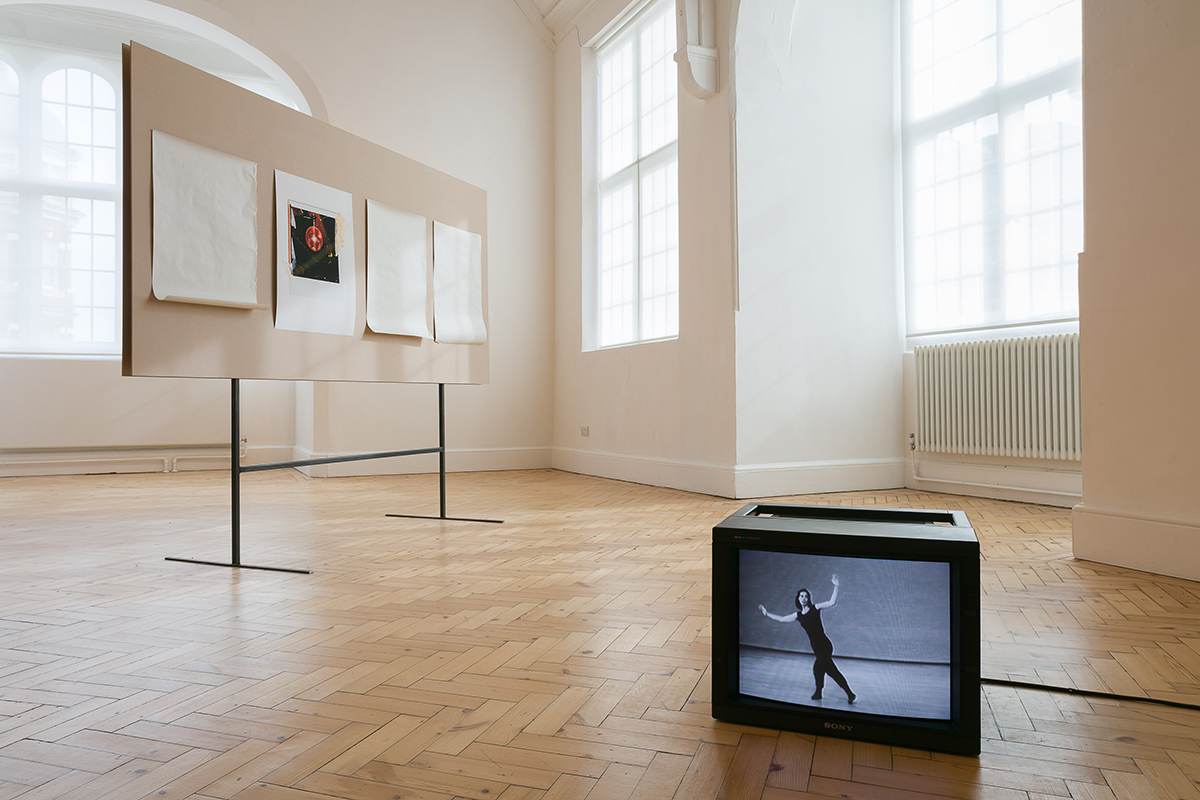
Ian White, Any frame is a thrown voice, 2018, installation view at Camden Arts Centre. Image courtesy of Mark Blower and Camden Arts Centre.
In the next room there was a reconstruction of White’s collaborative work with Jimmy Robert, Six things we couldn’t do, but can do now (2004/2018), originally performed at Tate Britain. In this staging, a video showed Robert and White re-performing Yvonne Rainer’s Trio A (1978) in front of an audience. At times it was fluid and mesmerising, at others clumsy—made clumsier in relation to Rainer’s original performance, which played on another screen across the room. Between the two monitors were two freestanding displays, on which were blown-up Polaroids and line drawings of legs. On one wall, blacked out diary pages were arranged neatly. Writing about the performance, White talks of grids:
Let’s say the performance itself was an instance that crystallised the passing of time into a series of actions, almost-abstractions drawn from out spending time together . . . then that they established an imaginary grid-like structure as a mechanism to measure the time spent with others during the performance, like a transfer or a channel, actions becoming like a kind of clock.12
There was the grid of the diary pages, there was the inevitable grid of the Polaroids and drawings on the freestanding displays—rectangles within rectangles—all of which leads us, maybe, to think of the body as a grid too. Here, Rainer’s movements are mapped onto White and Robert, at times awkwardly. In learning, in mimicking together, in repeating identical gestures in time with one another, White and Robert become mapped on to each other. If the work is, as White states, about passing time together, then it’s also about how the body becomes altered by that process. The body is malleable, and made vulnerable, subject to forces outside itself. Is it something essential to the performance that makes these bodies seem so vulnerable, or is it the knowledge that this scene has been reconstructed five years after White’s death?
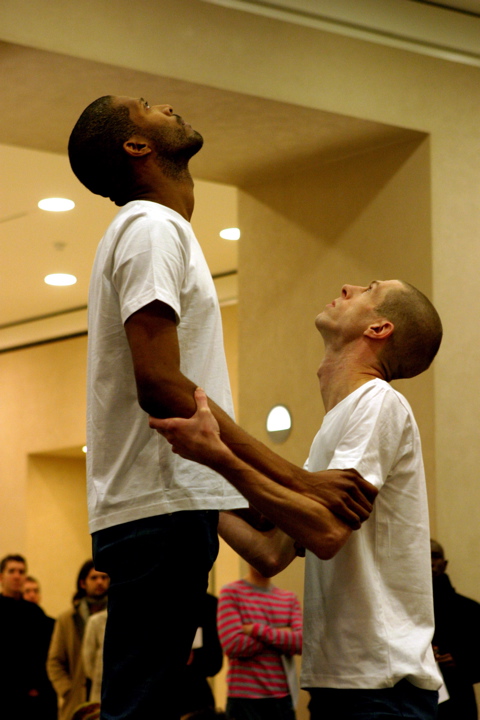
Ian White and Jimmy Robert, 6 things we couldn’t do, but can do now, 2004, performance for Art Now, Tate Britain, London. Image courtesy Sheila Burnett and the estate of Ian White.
In his writing, White developed a concept of “liveness” in relation to his performance, and performance generally. For White, it’s not enough that performers and audiences meet in space and time. There’s no guarantee of “liveness” in performance. Liveness, as Bell summarises, can “potentially be found in the broader contingencies of the event itself.”13 “The body,” White writes, “is a false promise.”14 It seems like a generous theory. Or, it seems to allow for distraction, a theory that doesn’t break apart when it fails, which I’m grateful for. It also might allow for a certain kind of “liveness” to be found in non-living objects, like a portrait of a long-dead pair of merchants. White remained a fan of Gainsborough. In a blog post written a decade after The Neon Gainsborough was first performed, White writes of looking at Mr and Mrs William Hallett (1785) in the National Gallery in London:
They are portrayed, we’re told, on or just before their wedding day. The trees and their clothing are a lot more torrid than you can tell by this reproduction. She might be wearing her wedding dress. They are merchants if nothing else for me than by their cheap-fine trippery that could be bought, ribbons and bows like Gainsborough’s sisters sold. And every single bit of frippery is flipping or fripping in the wind like every single leaf and the hairs on the dog. Am I this leaf or that one? And the asymmetry of the opening in the trees to say from where they come, they are emerging in a whirl/trap/whip/bubble. Where are they going? This is the fever of the mercantile, the nascent class, the buyers, unfixed in the very moment of their being painted, of their painting, their frenzy.15
There are obvious similarities between White’s and Berger’s readings of Mr and Mrs Andrews. But White goes on, substituting Berger’s seriousness for a willingness to be distracted, to be drawn in by what’s around him and what’s around the painting, for details that seem inconsequential to the image itself. A woman, standing behind White, looking at a painting by J. M. W. Turner, turns to her daughter and says, “Look, darling, it’s just exactly like those barbecues we have on Sundays.” White is delighted by this. Something so unexpected, so quotidian, and so revealing about these strangers. He finds himself thrown into some brief communion with these people. He ends the scene by writing, “Paintings subjected to time are also + people, living, correspondences.”16
Thomas Gainsborough, Mr and Mrs William Hallett (‘The Morning Walk’), 1785, oil on canvas. Image courtesy of The National Gallery, London.
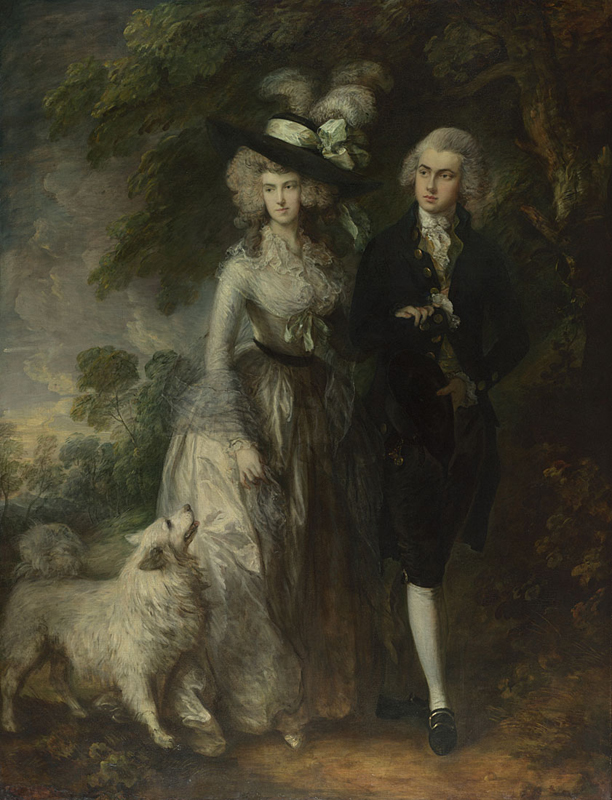
On my second day in England, we visited my grandmother’s body in the funeral home. Before being ushered into the chapel, we waited in a sparse room around a long table while preparations were made. Metal blinds half closed, letting in the late afternoon light. Boxes of tissues. In the corner, a display stand for Ashes to Glasses, a service that reduces cremation ashes into coloured gems. The display included examples; a small pendant, signet rings, something that looked like a paperweight. Beneath the specimens, a quote from a customer, “I feel so close to her when I wear it or just hold it in my hand.” The display stand was small, but it seemed to swallow the room. People mourn in their own ways, and if Ashes to Glasses helps people, then it’s probably a good thing. But the gems sent a jolt through me, not disgust, so much as surprise. It’s so profoundly strange to come across the body in a form I never knew it could take; to see it do something new when I thought I knew its limits.
In both Berger’s and White’s work the body appears fragile almost to the point of breaking, but also full of potential. Able to be moved, moulded by natural and political forces, as well as by the tenderness of companionship. Art moulds the body, too. Often in ways that are barely able to be registered. This relationship between Berger and White is mostly coincidental. They both happened to be with me at the same time. Neither offered any answers to the question I asked myself: why stay committed? Both, though, make looking and listening intense, newly exciting, and—perhaps most importantly—an exercise in deep compassion. Is it enough to say that what keeps me committed is that I’m still curious: to see more, to learn less, to be undone and remade?
